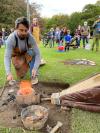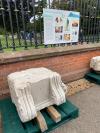St Anne's Park Community Archaeology Programme
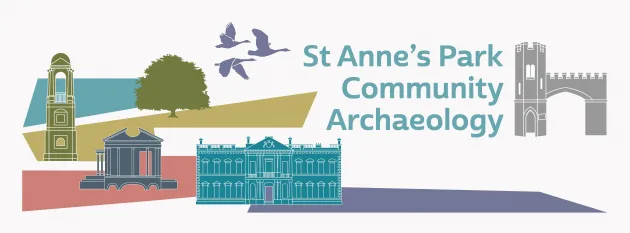
The St Anne’s Park Community Archaeology Programme was launched in 2021, and aims to connect local communities with archaeology, heritage, and social history, and the 19th-century designed landscape of St Anne’s Park. The programme has established the park as a city hub for people to try archaeology first hand and for training students in archaeological methods and techniques. It is an interdepartmental collaboration between Dublin City Council’s Planning, Property and Economic Development Department (Heritage and Archaeology Sections) and Parks, Biodiversity, and Landscape Services and has received grant support from the Heritage Council and Creative Ireland each year since 2021.
This year’s iteration of the programme will include a launch at the Rose Festival, a community excavation which will begin during Heritage Week, and a schools and TY programme. The details are as follows:
- Rose Festival, Saturday 19th and Sunday 20th July 2025 – an exhibition outlining the history and heritage of St Anne’s Park and details of community excavations to date. There will also be archaeological walking tours of the park.
- Community dig of St Anne’s mansion house – the excavation will commence during Heritage Week on Tuesday 19th August until Saturday 20th September (running Wednesday to Saturdays for adult volunteers)
- Finds Fridays – on Fridays in October volunteers will have an opportunity to process (clean, record, digitise and pack) archaeological finds discovered during the excavation
If you would like to volunteer on the community excavation, contact us at [email protected].

St Anne’s Park Heritage – A Guinness Estate
Why St Anne’s Park? St Anne’s Park is Dublin city’s second largest municipal park, which sits on the northern edge of Dublin Bay, between Clontarf and Raheny. Before it was transformed into a public space, the park formed part of a 202 hectare estate amassed by members of the Guinness family. In 1835, two grandsons of Sir Arthur Guinness, Benjamin Lee Guinness and Arthur Lee Guinness began to remodel a newly acquired house known as Thornhill (built c.1814) into a large Italianate-style residence, which they renamed St Anne’s after the nearby holy well. The house was again remodelled in the 1870s under the ownership of Lord and Lady Ardilaun (Arthur Edward Guinness and Olivia Charlotte Guinness) to become an exquisitely ornate palatial house. Following the deaths of Lord and Lady Ardilaun in 1915 and 1925 respectively, the estate was inherited by their nephew Bishop Plunket, who sold the house on to Dublin Corporation for £55,000 in 1939, after which it was used to store Defence Forces equipment during ‘The Emergency’. In 1943, a fire broke out turning the building to ruin, and it was ultimately demolished in 1968. The remains of the house lay untouched under a mound at the end of the avenue in St Anne’s until 2021, when the programme set out to uncover what remained. In addition to the house, the Guinness family built a series of follies around the estate which can still be seen today including the Herculanean Temple, the Bridge and Hermitage, the Rockeries, and the Roman Tower (which originally formed part of St Anne’s House). With such a wealth of heritage in the park and its role as a focal point for so many local communities, St Anne’s proved a perfect location for a Community Archaeology Programme.
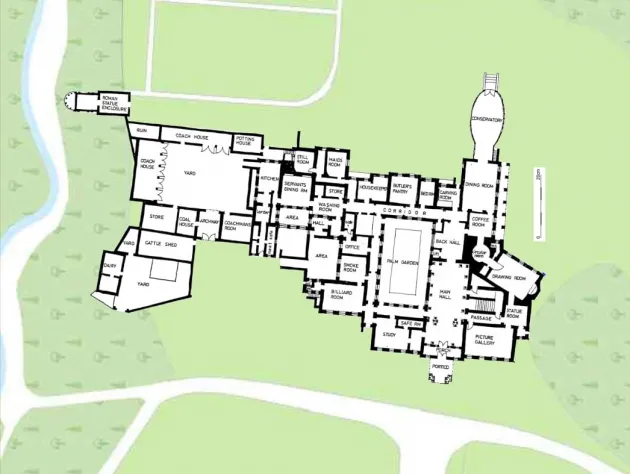
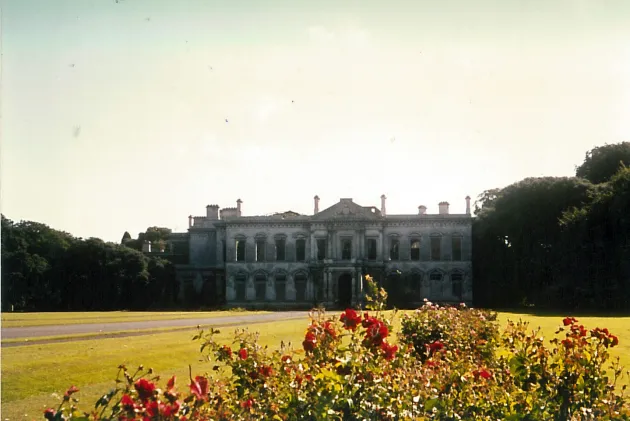
2021 Highlights
The Community Archaeology programme was launched in 2021 and was undertaken in line with COVID-19 safety measures. Preliminary archaeological testing took place earlier in the year to determine the extent to which surface remains of St Anne’s Mansion House (formerly Thornhill) survived in-situ. The event was launched on Saturday 18th September 2021 by the Lord Mayor of Dublin, Cllr Alison Gilliland. The exciting events of the day and the subsequent months included:
- A series of living history days facilitated by Claíomh were centred on three key themes; the Vikings and the Battle of Clontarf AD 1014, 16th Century Ireland and the War of Independence 1919-21. Living history practitioners in period costume displayed artefacts and brought them to life with demonstrations and short talks.
- Each month there was a Schools Day in the park for primary and secondary schools. Primary school pupils had the opportunity to partake in The Big Dig by the School of Irish Archaeology (SIA), a replica Viking house and a workshop excavation for children aged 5-12 years, guided by a team of professional archaeologists. Activity sheets were specially devised and made available to all primary schools for use in the park or classroom.
- In tandem with The Big Dig, there was an on-site Mobile Museum tailored to secondary school pupils. Pupils engaged with a suite of replica artefacts through which they learned about aspects of daily life in the past and key historic events. An activity sheet based on St Anne’s Park was made available to all secondary schools for teacher-led learning in the park or classroom.
- An exhibition about the park, Guinness family, St Anne’s House and recent archaeological excavations was hosted in the park for the duration of the programme, accompanied by a display of recently recovered architectural fragments from the house. Select walking tours of the park were hosted on the first Friday of each month.
- The online programme of events included a series of evening lectures by expert guest speakers. A bookable online archaeology Know your Locality course was delivered in 5 evening workshops, making participants aware of online sources for discovering more about the geological, archaeological and historical background of the area and north County Dublin.
2022 Highlights
In 2022, the St Anne’s Community Archaeology Programme comprised a series of public outreach events, an educational programme for primary and secondary schools and a community excavation. It commenced in July at the annual Rose Festival and culminated in September 2022 with a pilot 5-day community excavation.
Four individual stands/events took place at Dublin City Council’s Rose Festival in 2022, which took place over the weekend of Saturday 16th and Sunday 17th July.
- An Ask an Archaeologist display managed by ABH staff included material of prehistoric to modern date, including a stone axe, medieval floor tiles, ceramics and coins.
- A theatrical tour of the walled garden comprised an immersive theatre experience by Mrs Baker’s Medway Theatre Company whereby the audience met and interacted with former residents Lord and Lady Ardilaun and their Scottish gardener Andrew Campbell as they planned major improvements to the St Anne’s estate.
- The Pallasboy Project, under the leadership of master wood worker Mark Griffiths, provided an experimental archaeology wood working display to carve a replica of the Ralaghan Figure from Co. Cavan, and included a short talk and colouring activity and rewards for younger children.
- Archaeological walking tours were led by ABH archaeologist Wayne Malone twice a day starting from the Red Stables, covering the site of the mansion house, the Herculaneum Temple, the Boat House, the Roman Tower, and St Anne’s Well
On September 24th, an Experimental Archaeology Day was organised to coincide with the start of the community excavation, comprising four stalls; a reprise of the ‘Ask an Archaeologist’ display, demonstrations by the UCD Centre of Experimental Archaeology and Material Culture which explored bronze casting and stone carving, and a return of the Pallasboy Project wood carving display with the addition of bog butter containers.
An educational schools programme for primary and secondary pupils took place from September 19th-23rd. Primary School pupils were again encouraged to participate in The Big Dig by the School of Irish Archaeology, and secondary school students engaged in the Mobile Museum provided by Claíomh, accompanied by talks by Claíomh founder Dave Swift, a Heritage Expert with the Heritage Council’s Heritage in Schools Scheme.
A pilot community excavation took place from 24th-28th September with local volunteers and led by ABH archaeologists. In total 23 members of the public took part in the excavation. Visitors to the excavation were frequent, with the opportunity to engage with a professional tour guide on-site. The dig revealed parts of the Statue Room and Drawing Room of the former mansion house. In additional to numerous fragments of carved stone from the façade of the house, ornate plaster mouldings pieces of stained and painted glass, and ceramics dating from c. 1650 to the present day. All finds were recorded and processed, and the excavation was backfilled and the trench was reinstated by hand on the final day.
2023 Highlights
The 2023 St Anne’s Park Community Archaeology Programme was launched in July with an exhibition at the annual St Anne’s Park Rose Festival on Saturday 15th and Sunday 16th July, following which it comprised a four week community excavation (an expansion on 2022s five day excavation) which was launched during Heritage Week, and continued with the educational programme for primary and secondary schools.
Rose Festival activities included an exhibition stall with four A0 panels designed in collaboration with designer Paul Bokslag which detailed the history and development of the park and mansion house, and promoted the community archaeology programme, alongside a display of artefacts found during the previous year’s excavation. The exhibition was complemented by an expanded immersive theatre experience in the walled garden by Mrs Baker’s Medway Theatre Company. Concurrent displays by Claíomh Living History and The Big Dig by the School of Irish Archaeology provided additional activities for those of all ages.
The 2023 community excavation took place over 20 days from 11th September to 3rd October, Mondays to Saturdays inclusive. In total, community members contributed a total of 180 volunteer days to the excavation, and a transition year student participated in the excavation, mentored by Archaeology and Built Heritage Ltd.,. On Saturdays, a professional tour guide provided tours of the finds table and exhibition panels and information about the archaeological process to visitors. The volunteers uncovered substantial structural remains including the walls of the Picture Gallery, Statue Room, Drawing Room and a small vestibule/side entrance to the house. Additional elements uncovered included part of the mansion’s Portland stone façade, internal heating and plumping features, and structural remains of part of the earlier Thornhill House. Amongst artefacts recovered during the dig were fragments of stained window glass and tiles, lead window tracery, post-medieval ceramics, gas masks and elements of tents from its time as a storage facility for the Defence Forces during the Second World War. The excavated area was left uncovered and fenced off to allow for public engagement throughout the year.
The schools programme took place from September 17th to 22nd and comprised The Big Dig for primary schools, and the Mobile Museum for secondary school pupils, as outlined in previous years.
Excavation Director James Kyle delivered two lectures on the programme, one to the TCD Archaeological Society in November 2023, and one to the general public in Raheny Library in December 2023.
The results of the excavation inspired local artist Barry McAdam (Naniken Studios) to create a hand built 3D model of the house, which he superimposed on a drone photograph of the park (see below).
2024 Highlights
The 2024 St Anne’s Park Community Archaeology Programme was launched in July with an exhibition at the annual Rose Festival, followed by a five week community excavation which launched during Heritage Week. The programme’s activities included a dedicated programme for Transition Year students which built upon the pre-existing educational programme for primary and secondary schools.
The Rose Festival saw the launch of the programme, with an exhibition utilising the 2023 exhibition panels which detailed the history of the park and promoted the programme, updated to include the results of 2023’s excavation. Recently recovered artefacts were also on display, and ABH archaeologists engaged with members of the public (an estimated 1500 visitors).
The community excavation commenced during Heritage Week on Friday 23rd August, and ran for 25 days, Thursdays to Sundays inclusive, until Tuesday 24th September. Community members, mentored by Archaeology and Built Heritage Ltd., contributed a total of 245 volunteer days to the excavation. During the excavation, the exhibition panels were displayed alongside a finds table managed by a tour guide who engaged with members of the public, school tours, and casual visitors. A total of 11,610 visitors were recorded (excluding school tours). The 2024 area encompassed the central and southern extent of the mansion’s footprint, and included the Carriage Road, the front
half of the Picture Gallery, the Portico, the Porch and the western end of the Main Hall. The excavation uncovered the southernmost jostle stones which would have protected the stonework from damage from carriages, ceramic floor tiles in the former porch area (including tiles monogrammed with the initials AEG for Arthur Edward Guinness), iron pipes belonging to the central heating system, decorative stone and plasterwork, glass, and clay pipes, amongst other finds. In total, over 900 individual artefacts were recovered. Volunteers had an opportunity to participate in all aspects of the archaeological process, from the dig itself to recording finds, to public engagement.
In 2024, Finds Fridays was a new programme element in which ABH archaeologists and volunteers had an opportunity to process (clean, record, digitise and pack) archaeological finds discovered during the excavation, giving them the chance to partake in all parts of the archaeological process.
In 2024, the education programme comprised formal tours of the excavation and finds table and a dedicated programme ‘TY Tuesdays’ for Transition Year students. TY students were engaged in all aspects of the archaeological process, and proved particularly enthusiastic about the Finds Fridays display in which they could share their finds with visitors to the excavation.
Additional public engagement included an interview with Excavation Director James Kyle on the Amplify Archaeology Podcast, an Archaeology Ireland article, articles in several national papers (including the Irish Times and the Irish Independent), and a video captured by Arcade Film.
